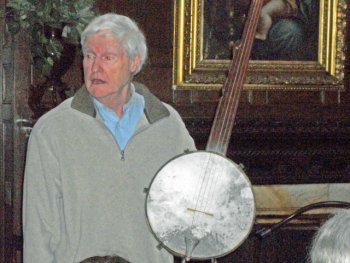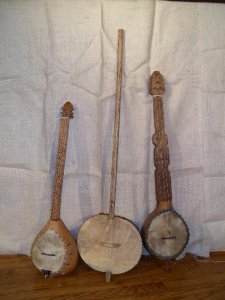Presentation by Bill Destler on the History of the American Banjo, March 18, 2013
Bill Destler, Rochester’s local banjo collector and world renowned authority on the subject, treated RGC to a memorable evening of banjo history, lore and hands-on demonstration. Bill brought with him quite a number of vintage and historic banjos all of which were in remarkable shape, in many cases ornately ornamented, and all quite playable. Bill’s collection is extensive, and he has made efforts to procure many of the banjo’s classic and historic models.

Bill talked at length about the history, the ornamentation and technological development of the banjo. The banjos Bill brought were built around 1840 to 1915. The banjo is of West African origin descending from a West African instrument called the akonting, http://en.wikipedia.org/wiki/Akonting brought over during the slave-trade era. The basic premise: a drum with a neck and at least one string. The banjo originated as a fretless instrument in this country, almost always with five strings. Most all were fretless and most of them were very plain.
One of the first known banjo makers in the United States was William Baucher, from Balitmore. Bill pulled out an example of his rare banjo work from 1845 with sculpted neck and friction tuners. Prior to the Civil War these were very, very rare. But in the 1840’s, Boucher began to make them en mass for a living. But in truth, didn’t make very many. http://www.vintagebanjomaker.com/#/boucher/4569315860
The Civil War itself was a huge factor in the popularization of the banjo. Soldiers were traveling, families were displaced and itinerant, and so music was on the move within the culture. Through this travel and intermingling, the banjo and much of the new repertoire made their way around.
After the Civil War the banjo became a favored instrument in minstrel shows. Blackface makeup making fun of African Americans was common along with black stereotyping during shows featuring banjo. As a result the banjo has become associated with this form of degrading black people and black cultural history, and there are very few African American banjo players today, even though the instrument is of African origin. Today these large-head, fretless banjos are still called minstrel-era banjos.
After the Civil War, as banjo’s popularity increased tremendously, thousands of banjos were manufactured in New York, Boston, Chicago and Philadelphia, the major industrial centers. They were shipped all over the country and priced from cheap to outrageously expensive. But there was something for everyone.
One of the innovators of the time was Henry Dobson, the inventor of the banjo resonator, circa 1860’s. In the 1870’s, ornamentation began using wood marquetry inlay. Fretless banjos predominated until frets came into the picture in the 1880’s with the advent of “silver rimmed” banjos which were made by the thousands to satisfy the exploding fad-like interest in banjos. Over 100,000 were made!

S.S. Stewart of Philadelphia formed a manufacturing company to make high quality instruments, making the banjo America’s Instrument, and developed classical repertoire for the great banjo orchestras of the 1880’s to 1890’s. There were piccolo banjos tuned an octave above a regular banjo, banjeaurines (a term he coined) tuned a fourth above which played the violin part in a banjo orchestra. He sold regular sized banjos, giraffe banjos, and cello/bass banjos tuned an octave below a regular banjo. Banjo orchestras continued into the 1930’s. Some were even recorded and a few recordings have survived.
At the time the banjo emerged, the instrument of choice was the parlor guitar. The banjo’s ability to be louder gave it the edge, thus driving its development, the technological changes and its emergence as the dominant instrument of the day. But then came the steel-string mandolin, and in the 1920’s, the steel-string, jazz banjos which were very loud. Eventually, with the advent of steel strings, larger bodies and longer necks the guitar came full circle. Loudness drove the market.
In the 1870’s and 1880’s saw-cut, pearl inlay came into use. It gave the banjo some class and enabled the price to go up, making banjo manufacture more profitable. Pearl inlay instruments sported high quality ornamentation and appointments. The more gaudy, the higher the price. One of the early inlay artists of the time worth noting was Eccilio Consolvey, who may not have originated the art, but did bring it to an extraordinary level, often using pearl inlay with engraving filled with ebony dust. The pinnacle of banjo construction in the U.S. was around 1910-15. Eventually precut pearl inlay became available from Germany making inlay more and more available. A single banjo of the period might sport hundreds of individual pieces of inlay. The most expensive known banjo of the period fetched $125, equivalent in today’s money to $10,000!
Early banjos were simply made with skin, drum heads stretched over a wooden ring. The tone was soft and warm. Metal hoops evolved to tighten the skin and provide some improvement in volume and tone through better coupling. Tone rings with adjusting screws evolved along with hoops to produce even more output. There were sometimes two-step tone rings that were mounted over two resonating structures, which again improved volume.
Today’s bluegrass banjo is really only a tenor banjo with a five-string neck added. Earl Scruggs re-necked a tenor Gibson banjo with a five-string neck, and bluegrass caught on. But early, original Gibson five-string banjos are exceedingly rare. Most all are re-necked tenors, and some are of such quality that they will fetch $50,000 and up!
Bill gave us all a chance to play the banjos on hand, and a good time was had by all. Here is Bill’s website for listings of instruments, photos and more of the banjo’s story: http://www.billsbanjos.com/
~Kinloch Nelson
Photos: R. Taglieri/K. Nelson
♫ Professor William Destler is currently serving as the ninth president of the Rochester Institute of Technology having held the position since 2007. Destler is “one of the world’s foremost collectors of antique banjos;” the number of instruments in his collection is purportedly more than 160. He is also an amateur folk musician and a founding member of the Baltimore Folk Music Society. Destler released his only record in 1973, “September Sky.”
Share this page: ![]() Facebook
Facebook
![]() Del.icio.us
Del.icio.us
![]() StumbleUpon
StumbleUpon
![]() Digg
Digg
![]() Reddit
Reddit
Home ::
About Us ::
Events ::
Articles ::
Resources ::
Contact Us ::
Links
©2007-2012, Rochester Guitar Club, All Rights Reserved, This page last updated 2013-06-10 09:02:57
Website by Red Beagle Web Development.








